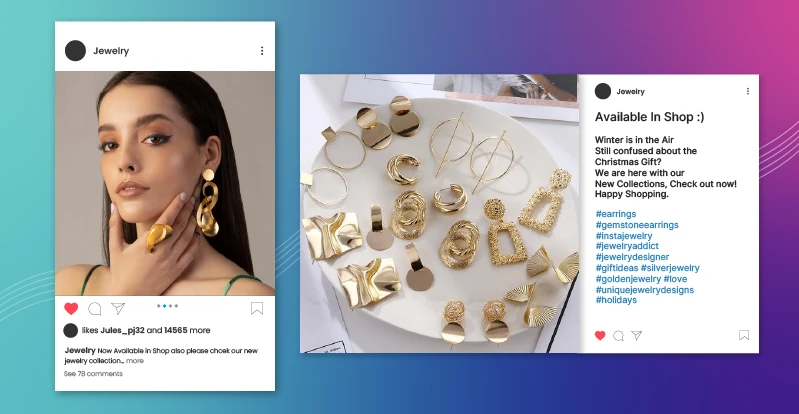Jewellery Business in 2024: Trends & Opportunities

Table of Contents
The jewellery industry is an expression of love and celebration. The personal connection and luxury of wearing it feels like a form of self-love and care. It’s not just a piece of jewellery which makes it beautiful and worthy of making it a part of our body. Instead, it’s an intricate layer of hard work of every person who made every piece remarkable and comes into the limelight.
Behind every piece of jewellery, there is a lot of effort from the brand, making it possible day and night to deliver the best experience to their customer. Every piece of diamond represents a lifelong devotion to hard work, which creates a brand legacy.
The jewellery industry is diverse and independent in terms of trends and demands. The brands that have established themself as key market players are setting trends and influencing the fashion industry. Ironically yet beautiful, even a tiny piece of jewellery can change and drive the fashion industry so beautifully.
According to ecommercedb.com, the jewellery eCommerce market is anticipated to expand by 13.5% by 2024. This follows a 10.8% growth rate in 2023. The market is then predicted to rise by 13.3% in 2025 before decreasing to 5.5% in 2026 and 6.3% in 2027.
With such a diverse industry, i.e. the jewellery industry, staying on top of trends and opportunities is not an option but a must. Trends come from consumer preferences, technology breakthroughs, and social crises, much like cyclones in the vast ocean. Understanding and adjusting to these trends is a strategic step for companies to grow with a flow.
With new styles coming, a brand in the jewellery industry needs a vision and sharp eyes like Hawkeye. Be it professionals or amateurs, you must know these upcoming trends and opportunities below.
Current Scenes of the Jewellery Industry
With an industry like jewellery, which is so unpredictable and challenging. Looking at current challenges and successes is essential to know what’s next. The market is dynamic, customer preferences keep changing, and it is shifting towards sustainable practices.
Recap of the State of the Jewellery Business in 2023
The past year, 2023, was full of experiences for the jewellery industry. There was a fluctuation in consumers’ spending patterns, which were influenced by global events and economic shifts. But it gave both challenges and opportunities. There were a lot of trends that changed the market for good.
As we look back and deconstruct the market patterns that characterised it. There were a lot of external factors which changed the narrative and flow of demand; the brands that were resilient and ready to adapt to change over time survived the trends and customer demands.
Significant Challenges Faced by the Industry
Every industry goes through a variety of changes and challenges. Many companies fail to survive through those challenges. The jewellery industry is no exception. Last year, the industry contended with a myriad of issues, including but not limited to supply chain disruptions, fluctuations in commodity prices and evolving consumer expectations.
Consumers have always opted for timeless designs and sustainable, modern practices, which require innovation and present a challenge for jewellery brands.
On top of that, economic uncertainties and geopolitical factors further added complexities to the industry. Understanding these challenges clarifies your jewellery business plan to make strategies that can work in this changing industry.
Growth Areas and Success Stories from the Previous Year
The past year was not just about challenges. Instead, it was also about growth and success stories that showed the resilience and adaptability of the jewellery industry. Glorious innovations in design, successful marketing trends, and strategic investments in sustainable practices stood out as milestones of progress.
Many successful brands in the UK have shifted to organic jewellery making, which most customers and even celebrities are opting for. For example, one of the best-selling UK jewellery brands, ie. Mejuri has been making trendy yet minimalistic jewellery that is too organic.
Similarly, a brand name, Monica Vinader, made a remarkable statement in 2020 by focusing on sustainability and recycled sterling silver and gold. This brand also focuses on sustainably sourced diamonds and pearls.
There’s so much more to learn from these kinds of brands and their success stories. Their ideas and plans performed well because they believed in taking a step and adapting as per market requirements. They took the leverage of digital transformation and made a run towards the futuristic vision. And beautifully, it turned out so well in their favour. These stories are an inspiration and benchmarks for the jewellery industry.
Upcoming Trends in Jewellery Design
As we look ahead to 2024, the global jewellery design marketplace discusses diverse trends that attract, challenge, and inspire. This part not only gives a broad overview of the design but also looks into the complexities of materials, styles, and the rising importance of ecological and ethical practices.
Overview of Design Trends in 2024
Materials and Textures
Beyond the traditional glimmer and shine of metals and gemstones, jewellery designers are experimenting with not-so-regular materials, generally referred to as unconventional materials. There’s an expected rise in the use of recycled and upcycled metals, lab-grown diamonds and innovative materials like sustainable resins and alternate gemstones. Their texture is mindblowing, and designers are exploring the different patterns, mixed metals and tactile elements which engage the senses.
Styles and Aesthetics
This is a generation where customers are crazy over aesthetics. Be it in the form of anything and the jewellery industry, there’s no shame in accepting that consumers demand stylish yet aesthetically pleasing designs. This shows that consumers’ tastes have evolved.
A beautiful mix of contemporary and classic styles is always in the limelight. Geometric shapes, asymmetry, and bold, statement pieces coexist with delicate, vintage-inspired designs. Minimalism continues to be a new norm, focusing on clean lines and simplicity. Cultural influences also come through variations in designs, which inspire on a global level.
Sustainable and Ethical Design Practices
Sustainability and ethics are no longer trends in the jewellery industry; they are necessities for giving the vision to future generations. In 2024, designers are aiming for eco-friendly practices in their creations.
From responsibly sourced materials to ethical labour practices, the industry is shifting significantly towards conscious consumption through these little yet remarkable steps. Brands gracefully promote transparency in their supply chains, allowing consumers to make better choices aligned with their values.
Developments In Technology Changing the Industry

The jewellery industry is undergoing a major change, usually influenced by technological developments affecting every sector aspect. In the following section, we look at how technology has changed manufacturing processes, how artificial intelligence is integrated into design and production, and how augmented reality and virtual try-ons create fully immersive experiences.
Technology’s Impact on Jewellery Manufacturing
Technology has become a major force in jewellery manufacturing, which has simplified processes and increased accuracy to levels that were not previously possible. For example, 3D printers and computer-aided design (CAD) tools have eased the production of elaborate designs.
Laser cutting and engraving technology have improved detail precision, making workers more creative. In addition, developments in casting processes and automation have resulted in much shorter production cycles, enabling quicker reactions to market demands and trends.
Artificial Intelligence in Design and Manufacturing
AI is more than just a term; it is a new face of innovation in jewellery design and manufacture. AI systems deal with massive databases and identify trends in customer tastes, assisting designers in creating marketable works.
Consider Swarovski (IL), a jewelry store that has had great success utilizing AI to create intelligent product collections. In just four weeks, they increased conversion rates by 18% and reduced non-moving inventory by 29%.
AI-powered design software aids in the creation of unique and customisable designs that respond to individual preferences. During manufacturing, AI is used for quality control, thus guaranteeing that each component meets the highest requirements.
Virtual Try-on and Augmented Reality in the Jewellery Retail Experience
The combined efforts of technology and the customer experience have resulted in fully integrated retail experiences such as augmented reality (AR) and virtual try-ons. AR apps will allow shoppers to try on jewellery virtually from the comfort of their own homes by 2024.
This technology improves the online buying experience and decreases the anxiety of purchasing high-value things without first seeing them. AR is breaking the traditional limits of the buying process, from picturing how a product matches an entire set to judging fit and feel. Virtual try-ons are no longer a temporary fad; they are becoming an important tool of the purchase decision-making process, controlling how customers interact with and invest in jewellery.
eCommerce and Online Marketing Possibilities

The digital transformation has brought groundbreaking potential for the small jewellery business in the UK, with eCommerce and online marketing developing as powerful growth channels. In this section, we will look at the growing trend of online jewellery purchasing, the strategic use of social media and digital platforms for marketing, and the critical elements of maintaining a solid online presence through good eCommerce techniques.
The Increase in Online Jewellery Shopping
Online purchasing has changed customer behaviour; the jewellery sector is no exception. Online platforms’ ease, accessibility, and wide range of options have encouraged the development of online business jewellery purchasing. In 2024, people will increasingly use web marketplaces to research, compare, and buy jewellery.
At the same time, going through the factors that have contributed to this growth, including the comfort of browsing across different collections and the trust given by crystal clear online transactions. Moreover, it shows the changed role of consumer evaluations and virtual consultations in improving the online jewellery buying experience.
Marketing through Social Media and Digital Platforms
Social media platforms have evolved into efficient tools for jewellery marketing, giving direct opportunities for customer engagement and product promotion. Successful companies deliberately use channels like Instagram, Facebook, and Pinterest to present engaging brand stories, display extraordinary pictures, and interact with their target audience.
Many brands have perfected the art of social media marketing, looking at how they use influencers’ collaborations, interactive content, and more. This creates a strong online presence in the market and promotes an eCommerce store with shoppable posts and direct purchase options.
eCommerce Strategies and Establishing a Strong Online Presence
It is not easy to figure out the complicated jewellery industry. Alas, when we look at jewellery firms’ most of the issues and offer strategic solutions for overcoming these barriers. There are a lot of practical strategies for solving particular difficulties related to industry, outperforming competitors and adjusting to the mood swings of consumer behaviour and economic situation.
Jewellery purchases are often shaped by the emotional context behind them. For example, with the rise of online dating, many customers prefer stylish and expressive pieces that help them make a memorable first impression. Meanwhile, jewellery chosen for long-term commitments or milestone moments tends to lean toward timeless, enduring designs. When businesses understand these different motivations, they can curate collections and marketing strategies that align with each stage of the customer’s journey.
Addressing Common Jewellery Business Challenges
Changing Commodity Prices:
Commodity, the variability of prices, particularly in precious metals and gemstones, can be an enormous risk to profit margins.
Brands can Implement an adjustable pricing approach that considers market ups and downs. Consider switching materials or forming long-term agreements with suppliers to minimise price fluctuations.
Changes in Consumer Preferences:
Quick changes in customer tastes can catch organisations off guard, resulting in obsolete inventory and lower sales.
A good solution for this is to stay updated on industry developments by doing ongoing market research regularly. Increase design and manufacturing flexibility to respond to shifting tastes quickly. Appeal for customer input and participate in discussions to better understand their changing preferences.
Ethical and Long-Term Practices:
Adopting ethical and sustainable methods can be difficult regarding material procurement and communicating these efforts to consumers.
Develop a transparent and traceable supply chain as a strategy. Use marketing platforms to promote your commitment to sustainability. Enlighten customers on the benefits of their decisions, and link their beliefs with your brand’s.
Overcoming Competition and Market Saturation Strategies
Brand Differentiation:
The jewellery industry can be overcrowded, making it difficult to distinguish among rivals. Determine your unique selling proposition (USP). This might be motivated by design philosophy, materials, or a desire to be environmentally responsible. Create a brand narrative that speaks to the people you want to reach.
Marketing Creativity:
Traditional marketing may not be enough in a world with short attention spans and high competition. Adopt highly sophisticated marketing tactics, including influencer collaborations, interactive content, and quality experience. Use social media to share amazing stories and connect with your audience emotionally.
Strategic Collaborations:
Competing as a small jewellery business against big brands is overwhelming. Form collaborative partnerships with relevant companies. Collaborate with influencers or other companies with a similar target audience. Collaborations and joint ventures can expand your reach and reputation.
By paying attention to these difficulties and adopting strategic solutions, jewellery companies might negotiate the industry’s complexity and present themselves for long-term development and success in a highly competitive marketplace.
Explore Related Topic: Explore Key Conversion Boosting Strategy for UK Jewellery eCommerce
Wrapping Up
At the end of our look into the jewellery industry in 2024, it is clear that imaginative thinking, adaptability, and a great awareness of the market’s conditions are the commands to success. According to Grand View Research, the market will increase by 8.1% CAGR, reaching $480.5 billion in value by 2025.
Following new patterns and focusing on opportunities can equip businesses to become successful in the constantly fluctuating field of jewellery. The future is bright for those who are willing to make a difference. Consulting with an expert can help you better understand the jewellery eCommerce. Grow brighter in the dynamic world of jewellery and uplift your sales.



